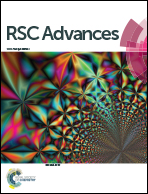Bioleaching of an oil-fired residual: process optimization and nanostructure NaV6O15 synthesis from the bioleachate
Abstract
The main objective of this work was to optimize metals recovery from a residual oil-fired ash produced in a thermal power plant using Acidithiobacillus ferrooxidans. Recycling precious metals that exist in oil-fired ash, such as vanadium, nickel, and copper, is very important because of their adverse environmental impact and their use in industry. Response surface methodology (RSM) was used to optimize effective factors, including initial pH, initial Fe2+ concentration, and pulp density. Under optimum conditions, including an initial pH of 1.3, initial Fe2+ concentration of 2.6 g L−1, and pulp density of 1% (w/v), maximum simultaneous recoveries for V, Ni, and Cu of 74%, 95%, and 88%, respectively, were obtained. Continuing, NH4Cl was used to precipitate vanadium from the bioleachate liquor by adjusting the pH to 9–10 using a 1 M NaOH solution. The produced ammonium metavanadate was calcined at 550 °C for 4 h to produce a high purity V2O5 powder. Single-crystalline NaV6O15 nanorods were synthesized by this novel, in situ reaction–crystallization process. The morphology, crystallinity, and chemical composition of the samples were investigated by X-ray diffraction (XRD), scanning electron microscopy (SEM), and energy dispersive X-ray (EDX), respectively. The discharge capacity at the specific current density of 0.02 A g−1, was obtained 231 mA h g−1 which is applicable for a lithium-ion battery.


 Please wait while we load your content...
Please wait while we load your content...